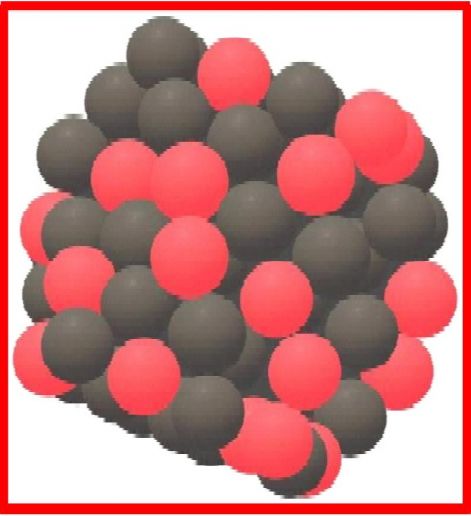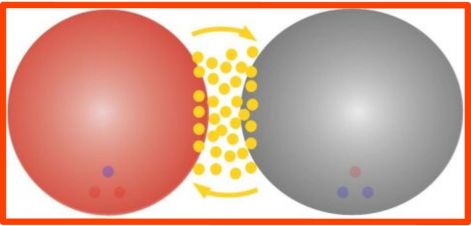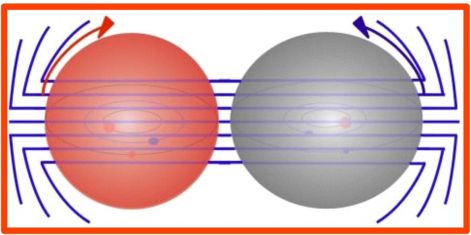The reactivated AETHER
Ide írhatod maximum 250 karakter hosszúságban a honlap leírását ill. szlogenjét. A leírás fontos a weboldal látogatottá tételében, ezért érdemes jól megszövegezni.
The strong interaction- which is not!
"Strong interactions are one of nature is four fundamental interactions. It is the strongest of them." writes Wikipedia.”
The science of modern physics has 4 fundamental interactions between material bodies. These are gravity, electromagnetic interaction, strong interaction, weak interaction. Physicists have assigned different mediator particles to each interaction. These are the graviton, photon, gluon, and the W +, W -, and Z bosons, respectively. Unfortunately, the physical parameters of these mediator particles are either uncertain, contradictory, or lacking any support.

Figure 1. The Atomic nucleus from the point of view of "today's" physics
For the outside observer, only the need for a hidden attraction between protons and neutrons is obvious, as they are stably assembled into larger spheres, namely against strong electric forces. The nucleons appear to be glued together with a very strong but very flexible adhesive. It has therefore become necessary for the new entity to be given a clear name as soon as possible. Instead of calling the common name “very strong glue,” physicists registered it in jargon as a less informative “strong interaction”.
Do gluons mediate strong interactions?
Gluon is derived from the English word glue, as scientists invented this hypothetical particle specifically for gluing together nucleons in the nucleus. To this day, gluons are presumed incarnations of strong interactions. Incidentally, science distinguishes 8 subspecies of gluons, although unfortunately, it has not even come close to exploring the mechanism of action of the attractive-effect. I would like to point out here that it is not even possible to exert an attractive force with the help of flying balls. Such an experiment is geometrical and physical nonsense, but some nonsenses has been introduced by the "modern"physicists already.
Physicists release gluons from protons through light-velocity collisions. Due to this, quite a few parameters were determined. According to Wikipedia, “Gluon was experimentally discovered in 1979. According to the theory of quantum color dynamics (QCD), these mediators are massless particles. Like quarks, gluons have a color charge, more specifically color and an anti-color.” An important addition is that the spins of gluons are 1 (expressed in the correct unit 105e-36 kgm2 / s), while their mass and electrical charge are 0.

Figure 2. Attracted by flying yellow gluons the balls together?
From a technical point of view, there is an even more difficult and even unanswered question. Is it possible to exert attraction with reciprocating particles? Applying pressure is perhaps possible while attractive force is impossible, so the latter is nonsense! In looking for an analogy, consider the terms suction and attraction, which are frequently used in everyday life. Suction doesn't exist anywhere, in which case a concealed compressive force drives the system. A well-known example is an old-fashioned pump well. A pipe leads from the top of the well to the lower water mirror, and up there is a deaeration with a mechanical arm. This is not the case, but the barometric pressure on the water mirror at the bottom of the well pushes the water up to the outlet pipe of the well, up to 10 metres high. The situation is misleading because the air, as well as its pressure, are invisible. From now on, the ether (the physical vacuum) comes to the fore, which is invisible like air, except that its pressure is much, much higher.
As a lesson from the above, let’s face it, while gluon may be good for a lot of things, it certainly isn’t for holding the nucleons of the nucleus together.
The Strong magnetic attraction
Few people realised that experimental physicists had measured a strong magnetic field around the nucleons. The proton has a magnetic torque of Tp = +14.1 e-27 Am2 (amperes square meter). At the same time, a magnetic torque of Tn = -9.55 e-27 Am2 was measured at the neutron. These numbers appear small at first glance, but note that they refer to very small spheres of 1.76 fm (femtometer). It is a very big task for these small spheres to produce such a large magnetism.
A u quark orbiting on the outer surface of a proton generates a current of 5.784 amperes, which creates an extremely strong magnetic field. The d quark orbiting the outer surface of the neutron, on the other hand, generates 4.222 amperes, which also produces a strong magnetic field around the neutron. The nucleus is built with neutrons inside and magnetically attracted to each other. The protons stick to the outer surface, and although they repel each other, their very strong magnetic attraction keeps them there. (See the detailed calculation here!) ( The 2 - 2 quarks circulating inside exactly balance each other's magnetic effects, so they do not appear outward ).
In the neutron, the magnetic effect is created by an external d quark. The circular current of quark d is 4222 amperes. At this numerical value, we generously ignore reality for simplicity. This is because the neutron is 37% larger than the proton, but in this dissertation, it may not be necessary to cover the differences. Another representation problem is that the circulating quarks are located in the plane of the drawing. They need to be set up to 3D. The outgoing magnetic lines of force are thus formed correctly.
After exploring the internal composition of the atomic nucleus (1934), the most natural idea was to look for some adhesive medium that would hold the balls together. No such glue had been known before, but it was given a name: Strong Interaction. Unfortunately, it was not thought that the known magnetic interaction might be strong enough inside the nucleus. They never dreamed that extremely strong currents could exist inside nucleons, creating an extremely strong magnetic field. This force is amply sufficient to overcome strong electrostatic forces. Well, magnetic attraction is the ultimate solution.

Figure 3. Strong magnetic attractionexerted by magnetic lines of force
The scientific community often cites the reverence and rebuke of Reverend William Ockham, a medieval Anglican pastor, and naturalist, for his colleagues: "When you form a new theory, add a new entity only as a last resort, i.e. do not multiply the number of known entities unnecessarily." Unfortunately, contemporary scientists did not heed the rebuke and coined the concept of strong interaction. Though they knew the magnetic attraction, they just didn’t believe it would be able to exert enough cohesive force inside the nucleus. Not so long ago, however, I was able to construct a coherent and reliable theory of the internal structure of the proton and neutron. An integral part of this is the appearance of very strong magnetic fields.
Regardless of the construction of the above current-carrying nucleons, the magnetic torques Tp and Tn have long been measured. These cover high values of strong currents and very high values of external magnetic forces. Therefore, it would have been inevitable in the past for physicists to create and introduce the concept of strong magnetic attraction, regardless of the failure to fit the internal system and geometry of nucleons to the problem.
It is now inevitable for physics to comply with the Ockham principle. That they should reject the empty notion of a strong interaction that has become unjustified! At the same time, the opportunity arises, and even obvious, to introduce the strong magnetic attraction, the old, reliable, and numerically perfectly functioning magnetic interaction.
Calculated data: Proton 
Original date: 30.09.2020.
Keywords: Gluon, proton, neutron, strong interaction
Tom Tushey
Mechanical engineer
Hobby physicist
Scientific writer
Relativity-expert
reactivated-aether@c2.hu
Honlapkészítés ingyen:
Ez a weblapszerkesztő alkalmas
ingyen weboldal,
ingyen honlap készítés...
Mai: 13
Tegnapi: 22
Heti: 116
Havi: 347
Össz.: 20 031
Látogatottság növelés
The reactivated AETHER - © 2008 - 2026 - reactivated-aether.hupont.hu
